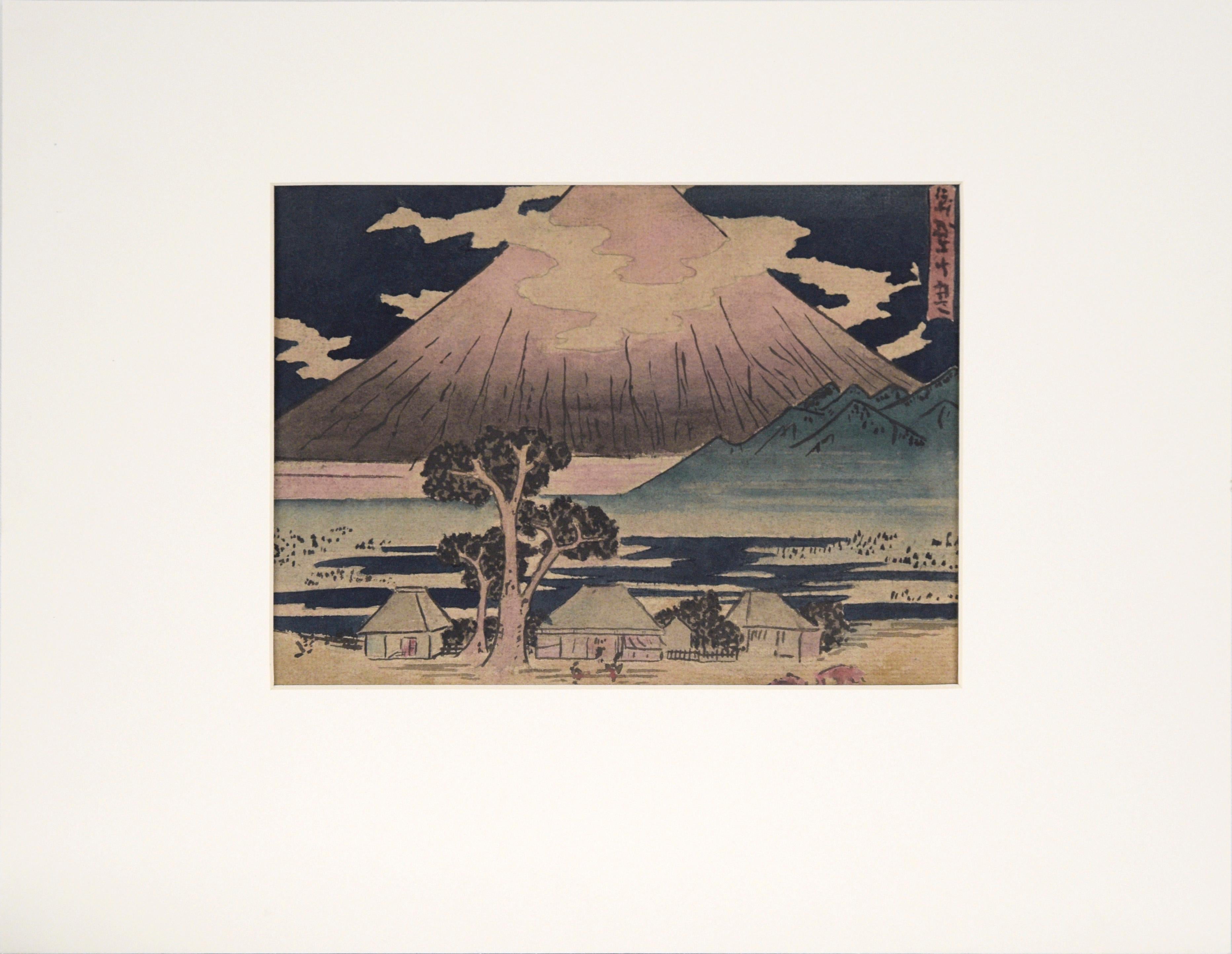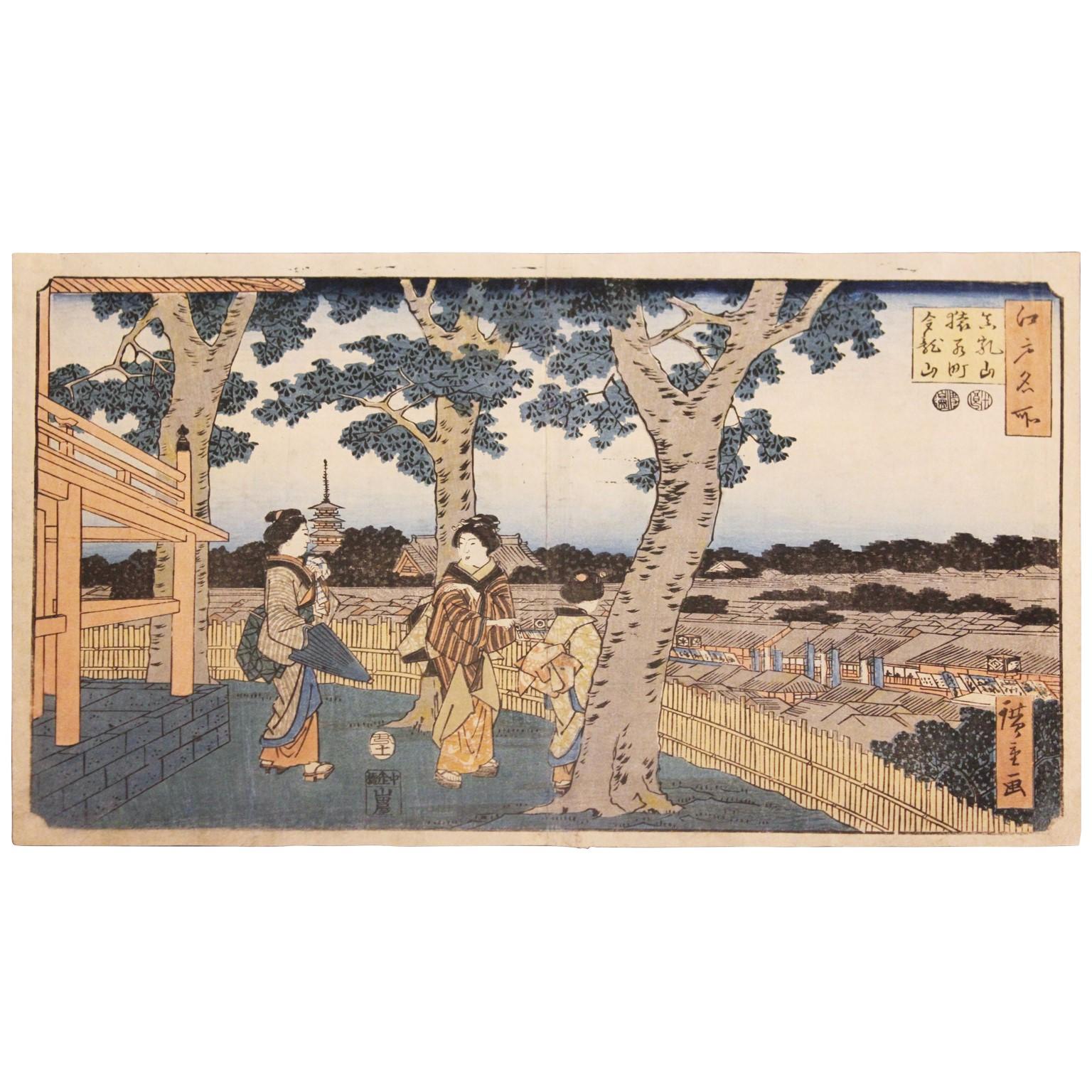Items Similar to Edo Landscape Japanese Woodblock Print
Want more images or videos?
Request additional images or videos from the seller
1 of 9
Utagawa Hiroshige (Ando Hiroshige)Edo Landscape Japanese Woodblock Print1850's
1850's
About the Item
Edo Meisho woodblock print of a famous Japanese coastal dock. This woodblock is most likely apart of the series "One Hundred Famous Views of Edo." The woodblock print is printed on rice paper. The print is not framed.
Artist Biography: Born in Edo as Tokutaro Ando, Hiroshige grew up in a minor samurai family. His father belonged to the firefighting force assigned to Edo Castle. It is here that Hiroshige was given his first exposure to art: legend has it that a fellow fireman tutored him in the Kano school of painting, though Hiroshige’s first official teacher was Rinsai. Though Hiroshige tried to join Utagawa Toyokuni’s studio, he was turned away. In 1811, young Hiroshige entered an apprenticeship with the celebrated Utagawa Toyohiro. After only a year, he was bestowed with the artist name Hiroshige. He soon gave up his role in the fire department to focus entirely on painting and print design. During this time he studied painting, intrigued by the Shijo school. Hiroshige’s artistic genius went largely unnoticed until 1832.
In Hiroshige’s groundbreaking series, The 53 Stations of the Tokaido (1832-1833), Hiroshige captured the journey along the Tokaido road, the highway connecting Edo to Kyoto, the imperial capital. With the Tokugawa Shogunate relaxing centuries of age-old restrictions on travel, urban populations embraced travel art and Hiroshige became one of the most prominent and successful ukiyo-e artists. He also produced kacho-e (bird-and-flower pictures) to enormous success. In 1858, at the age of 61, he passed away as a result of the Edo cholera epidemic.
Hiroshige’s prints continue to convey the beauty of Japan and provide insight into the everyday life of its citizens. The appeal of his tender, lyrical landscapes was not restricted to the Japanese audience. Hiroshige’s work had a profound influence on the Impressionists and Post-Impressionists of Europe: Toulouse-Lautrec was fascinated with Hiroshige’s daring diagonal compositions and inventive use of perspective, Van Gogh literally copied two prints from Hiroshige’s famed series, 100 Famous Views of Edo in oil paint.
- Creator:Utagawa Hiroshige (Ando Hiroshige) (1797-1858, Japanese)
- Creation Year:1850's
- Dimensions:Height: 10 in (25.4 cm)Width: 15 in (38.1 cm)Depth: 0.004 in (0.11 mm)
- Medium:
- Movement & Style:
- Period:
- Condition:Wear is consistent with age.
- Gallery Location:Houston, TX
- Reference Number:

About the Seller
5.0
Vetted Seller
These experienced sellers undergo a comprehensive evaluation by our team of in-house experts.
Established in 1969
1stDibs seller since 2014
785 sales on 1stDibs
Typical response time: 5 hours
- ShippingRetrieving quote...Ships From: Houston, TX
- Return PolicyA return for this item may be initiated within 7 days of delivery.
More From This SellerView All
- Saruwaka-machi District and Kinryûzan Temple Seen from MatsuchiyamaBy Utagawa Hiroshige (Ando Hiroshige)Located in Houston, TXThree women in the Saruwaka-machi District with a view of Kinryûzan Temple seen from the famous landmark Matsuchiyama. The woodblock print is from the series "Famous Places in Edo". ...Category
1850s Edo Figurative Prints
MaterialsWoodcut
- Boat with Houses Landscape Woodblock Print (Possibly Woodstock School of Art)Located in Houston, TXSmall black and white woodblock print depicting boat with houses. Possibly from the Woodstock School of Art. Inscribed and signed by artist. ...Category
Mid-20th Century Expressionist Landscape Prints
MaterialsWoodcut
- "Nara" Japanese TownscapeBy Kiyoshi SaitōLocated in Houston, TXLandscape print of small Japanese city, Nara (A). Signature and seal lower right. Mat board covers the margins which may have date, title and edition. Non-glare glass makes inspection and photography difficult. Visible Area: H 15 in. x W 20.5 in. Artist Biography: Kiyoshi Saito was born in Fukushima prefecture in 1907. At the age of five he moved to Otaru in Hokkaido, where he would come to serve as an apprentice to a sign painter. Saito became infatuated with art after studying drawing with Gyokusen Narita and moved to Tokyo in 1932 to study Western-style painting at the Hongo Painting Institute. He began experimenting with woodblock prints and exhibiting his works with Nihon Hanga Kyokai in 1936. Saito mainly worked in oil painting until his invitation from Tadashige Ono...Category
20th Century Modern Landscape Prints
MaterialsWoodcut
- "Le Grand Staircase" Modern Abstract Lithograph Edition 25/50By Suzanne RunacherLocated in Houston, TXAbstract lithograph of a staircase. The work is signed and editioned by the artist in pencil. It is framed in a unique wooden frame. Dimensions Without Frame: H 30 in x W 24 in. Ar...Category
20th Century Naturalistic Landscape Prints
MaterialsLithograph
- "BaitHouse" Seascape Landscape Etching Signed Anderson Edition 8/10Located in Houston, TXEtching of a seascape with a boat house and boats. The peice is titled, signed, dated, and editioned in pencil by the artist. The etching is framed in a wooden frame with a white mat...Category
1960s Naturalistic Landscape Prints
MaterialsEtching
- Two Landscape Print StudiesBy Carol GrayLocated in Houston, TXTwo prints of landscape studies framed in a single frame together. Images are signed by the artist in the lower right corner. Framed in a gold frame with a purple matte. Artist Bio...Category
Late 20th Century Impressionist Landscape Prints
MaterialsLithograph
You May Also Like
- "Plovers at Tamagawa" from "Six Jewel Rivers" - Woodblock Print on PaperLocated in Soquel, CA"Plovers at Tamagawa" from "Six Jewel Rivers" - Woodblock Print on Paper This print, sometimes titled "Chidori No Tamagawa" "Plovers at Tamagawa", is from the series Mu Tamagawa ("Six Views of Tama River", also known as "Six Jewel Rivers" or "Six Crystal Rivers") by Kubo Shunman...Category
Late 18th Century Edo Landscape Prints
MaterialsPaper, Ink, Woodcut
- Study of Utagawa Hiroshige's "View of Hara-Juku" 53 Stations of the Tokaido RoadBy Utagawa HiroshigeLocated in Soquel, CAStudy of Utagawa Hiroshige's "View of Hara-Juku" 53 Stations of the Tokaido Road Hand painted study of Utagawa Hiroshige's "View of Hara-Juku", (by unknown artist), from "53 Station...Category
1920s Edo Landscape Prints
MaterialsWoodcut, Paper, Ink
- Narihira's Journey to the East - Japanese Woodblock on Paper by Kikugawa EizanBy Kikugawa EizanLocated in Soquel, CANarihira's Journey to the East - Japanese Woodblock on Paper Original 19th century Japanese woodcut print depicting Narihira's journey to the East by a follower of Utamaru, Kikugaw...Category
Early 19th Century Edo Figurative Prints
MaterialsWoodcut, Rice Paper, Ink
- "Various Himochi" Wagashi Festival Japanese Woodblock Print by Utagawa ToyokuniLocated in Soquel, CA"Various Himochi" Wagashi Festival Japanese Woodblock Print by Utagawa Toyokuni Rare oversized early 19th century 5-tiered woodblock by Utagawa Ichiyosai Toyokuni, (Japan, 1769-1825), a Japanese lord and wife oversee a sekku festival of food, music, and dolls or toys. '"oshi" is the first day of “Mi (Snake)” in the third month of the lunar calendar. This day, known in modern Japan as the Girls' Festival, originated in China as a form of purification ceremony in which water and drinking peach blossom wine were used to drive away evil. Many kinds of hishi-mochi appear in this picture of hina ningyo (dolls associated with Hinamatsuri, or the Girl’s Day) from Omochae. The custom of eating special dishes at events throughout the year and at milestones in people's lives has existed since ancient times. This paragraph specifically focuses on the annual event called sekku, and life events that involve eating sweets. Joshi is the first day of “Mi (Snake)” in the third month of the lunar calendar. This day, known in modern Japan as the Girls' Festival, originated in China as a form of purification ceremony in which water and drinking peach blossom wine were used to drive away evil. According to the Keiso saijiki, in ancient China, on the third day of the third lunar month, people ate “ryuzetsuhan,” which is the juice of gogyo (Jersey cudweed) mixed with rice flour and nectar. In Japan, there is a record in the Heian period history book Nihon Montoku tenno jitsuroku [839-5] that it was an annual event to make kusamochi using gogyo on the third day of the third month of the lunar calendar, which may have been influenced by Chinese customs. The tradition of eating kusamochi on the third day of the third month of the lunar calendar continued after that. By the Edo period, however, hishimochi had come to be used as a sweet to serve on the third day of the third month. A picture of a hishimochi is included in the Morisada manko , which we mentioned in Part 1. According to it, hishimochi in the Edo period were often three layers of green-white-green instead of the now common red-white-green. However, it is possible to see from our collection that not all hishimochi were made in this way. Omochae published in 1857, is a good example. Omochae is a type of ukiyoe print...Category
1820s Edo Figurative Prints
MaterialsInk, Rice Paper, Woodcut
- Beauties on the Beach with view of Mount FujiBy Yoshu ChikanobuLocated in Burbank, CAShichirigahama, Sagami Province. A beauty in the foreground waves to her young companions, who run towards her on the beach. The beauty at left wears a western-style golden ring. We ...Category
1890s Edo Landscape Prints
MaterialsMulberry Paper, Handmade Paper, Woodcut
- Mitate of a Daimyo's Procession Crossing Ryogoku Bridge - Woodblock PrintBy Keisai EisenLocated in Soquel, CAMitate of a Daimyo's Procession Crossing Ryogoku Bridge - Woodblock Print Woodblock print of a procession by Keisai Eisen (Japanese, 1790–1848). Terrific triptych of a procession of...Category
Early 19th Century Edo Figurative Prints
MaterialsWoodcut, Rice Paper, Ink
Recently Viewed
View AllMore Ways To Browse
Antique Flower Print
Hundred Antiques
Japanese Painting Edo
Edo Paint
Japanese Woodblock Prints Framed
Japan Antiques
Japanes Antiques
Japaneses Antiques
Japanese Art And Antiques
Japanese Rice Paper Painting
Japanese Woodblock Beauties
Kano School
Antique Print Coastal
Fire Department Antique
Bird Print 1850
Japanese Woodblock Flower Prints
Japanese Print Toyokuni
Coastal Bird Paintings





